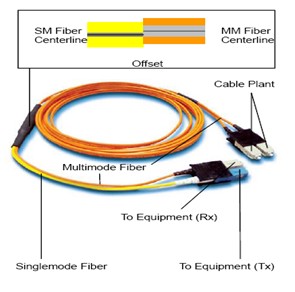The 802.3z standard (IEEE) for Gigabit Ethernet over optical fiber was released to satisfy the demand for higher bandwidth. While 1000BASE-LX transceiver modules can only operate over single-mode fibers. Then what if the transceiver must be employed over both single-mode and multimode fibers? The problem of differential mode delay (DMD) occurs when single-mode fiber is launched into a multimode fiber—it will generate multiple signals that confuse the receiver and lead to inevitable errors. If you ever encounter such a problem, a mode conditioning cable is much needed to help. This article is about some rudiments of mode conditioning cable.
What Is Mode Conditioning Patch Cable?
Mode conditioning patch cable functions the same way as a standard patch cable, however, its mode-conditioning unit consists of a cable assembly with an offset single-mode fiber to multimode fiber connection point and duplex connectors on each end. It is basically a duplex multimode cable that has a small length of single-mode fiber at the start of the transmission length. With two multimode fibers on one end and one multimode and one single-mode fiber on the other end. The mode-conditioning patch cord is suitable for long-wavelength multimode applications like Gigabit Ethernet.

How Does Mode Conditioning Patch Cable Work?
The basic working principle of mode conditioning patch cable is that, the launch of the light coming out of the equipment begins on a single-mode fiber, and the single-mode fiber is precision fusion spliced to the multimode fiber to a precise core alignment (see picture below). The light is launched on to the multimode fiber at a precise angle, giving the cable its mode conditioning properties.

By using an offset between the single-mode fiber and the multimode fiber, mode conditioning patch cords eliminate DMD effectively. And the resulting multiple signals make it possible to use 1000BASE-LX transceivers over multimode fiber systems. This is considered to be a cost-effective and energy-saving solution since there is no need to upgrade the whole fiber plant.
Tips for Using Mode Conditioning Patch Cable
Mode conditioning patch cables are available from various vendors on the market, so it is important to know where and when they should be used.
1.Mode conditioning cable is normally used in pairs. That means that you will need this cable at each end to connect the equipment to the cable plant. So then, these cables are usually ordered in even numbers. The usual reason why someone may order one cable is so they may keep it as a spare.
2.If your Gigabit Lx switch is equipped with SC or LC connectors, be sure to connect the yellow leg (single-mode) of the cable to the transmit side, and the orange leg (multimode) to the receive side of the equipment. It is imperative that this configuration be maintained on both ends. The swap of transmit and receive can only be done at the cable plant side. (see the picture below)

3.Mode conditioning patch cords can be only used for single-mode to multimode conversion. If you want to convert multimode to single-mode, then a media converter will be required.
Mode Conditioning Patch Cable Installation
Looking at the mode conditioning cable assembly in the following picture, we can see that the fusion splice is protected by a black over-wrap. On the left side there is an orange and a yellow cable, and this is the side of the cable that connects to the gigabit equipment, with the yellow single-mode leg to be connected to the transmit side.

Here we provide some steps to follow when installing mode conditioning patch cable:
- Step1: Connect the yellow leg (single-mode connector) of the cable into the transmit bore of the transceiver.
- Step2: Connect the rest orange legs (multimode connectors) of the cable into the receive bore of the transceiver.
- Step3: At the other end of the patch cord, put all the orange legs (multimode connectors) into the patch panel.
- Step4: Repeat the above three steps for the second transceiver located at the other end of the network link.
Conclusion
Mode conditioning patch cable offers an optimum solution for improving data signal quality and increasing transmission distance. It is available with various options of different connectors, jackets and lengths. Hope this article could provide you some useful information and constructive suggestions.

No comments:
Post a Comment